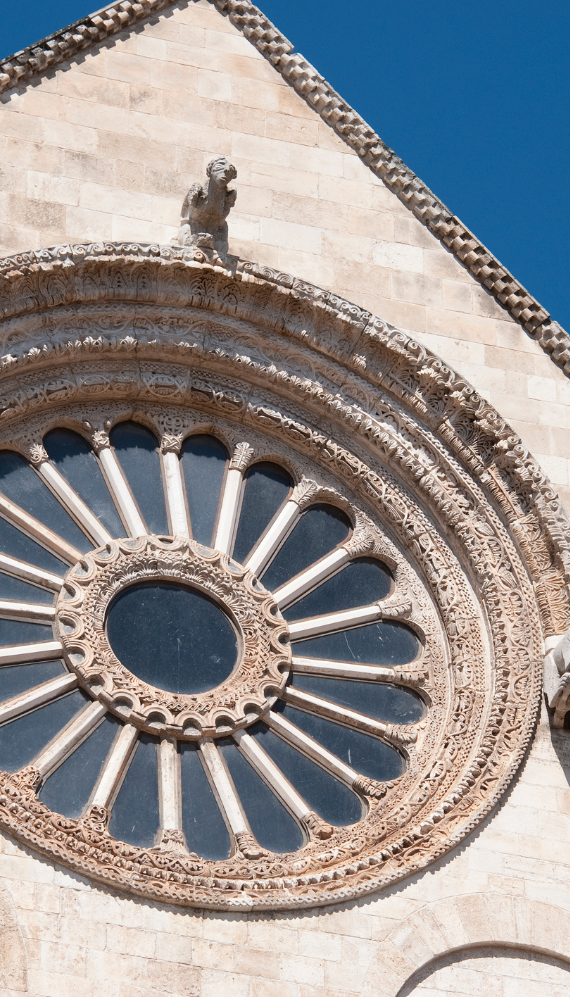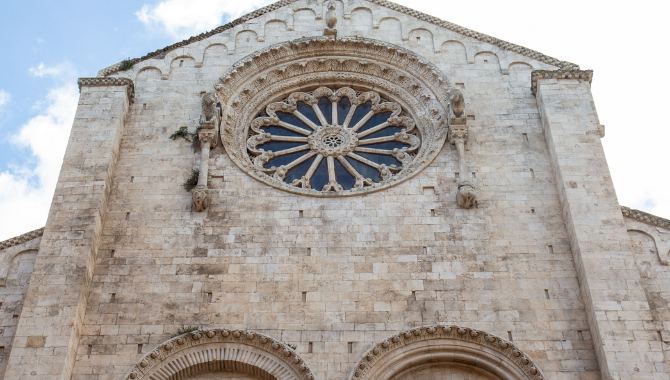
Bitonto: between history and religion
Itinerary description
The guided tour of Bitonto begins with access to the ancient medieval village through the Porta Baresana, near which stands the Torrione Angioino.
Entering Piazza Cavour, you come across the seventeenth-century church of San Gaetano, Palazzo De Ferraris Regna, built in the 1400s by a Genoese family, Palazzo Sylos Calò, current headquarters of the National Gallery of Puglia - Pinacoteca Devanna and the Church of Purgatorio, with its particular portal decorated with skulls.
Continuing along via Giandonato Rogadeo, also known as via dei Mercanti, you come across the private chapel of Santa Maria della Pietà, near Palazzo Bovio, and the eighteenth-century Palazzo Rogadeo of the same name, seat of the Civic Museum and the Municipal Library of Bitonto.
In the immediate vicinity stands the splendid Cathedral, or Duomo, dedicated to San Valentino and Santa Maria Assunta, built starting from 1087, on the model of the Basilica of San Nicola in Bari.
The sloping facade is tripartite due to the presence of pilasters, with three richly decorated portals, four mullioned windows and a splendid rose window decorated with palmettes.
Particularly interesting is the crypt that preserves the ancient Paleo-Christian Basilica restored a few years ago to its former glory with the extraordinary perfectly intact mosaic depicting the mythological Griffin.
In the Cathedral Square there is also the Guglia dell'Immacolata, built as a votive offering after a violent earthquake in the 18th century and Palazzo de Lerma, connected to the Cathedral via a sixteenth-century loggia, called "of the blessings".
Near the Cathedral there are some of the oldest and most important bitontine religious buildings, such as the Church of San Silvestro, dating back to the beginning of the 12th century, and the Monastery of Santa Maria delle Vergini, with its Byzantine icon of the Madonna dell' Bow.
Walking along the winding alleys of the historic interior, you will come across various period buildings, such as Palazzo Scaraggi, Palazzo Vulpano Sylos, the oldest place of worship in the city, namely the Church of San Leucio Vecchio, the Church of San Francesco d'Assisi, d' Gothic origin, located near the Porta La Maja or del Carmine.
Travel duration
1-3 hours
Points of interest
Cathedral of Maria Assunta
The magnificent co-cathedral of Bitonto presents an interesting detail: the so-called "Gate of excommunication", from which Pope Gregory IX excommunicated Frederick II, accused of having compromised with Sultan Al Kamil during the crusade of 1228.
Also known as the cathedral of Bitonto, it is part of the archdiocese of Bari-Bitonto. Main place of worship in the city, it is dedicated to St. Valentine, of which there are relics inside the altar. It has been recognized as the most complete example of Apulian Romanesque architecture. The co-cathedral was built during the 12th century on the model of the basilica of San Nicola di Bari and preserves inside an ambo and a mosaic of great interest.
Path
Gallery

